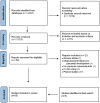Phthalate Exposures and Placental Health in Animal Models and Humans: A Systematic Review
- PMID: 35686923
- PMCID: PMC9333406
- DOI: 10.1093/toxsci/kfac060
Phthalate Exposures and Placental Health in Animal Models and Humans: A Systematic Review
Abstract
Phthalates are ubiquitous compounds known to leach from the plastic products that contain them. Due to their endocrine-disrupting properties, a wide range of studies have elucidated their effects on reproduction, metabolism, neurodevelopment, and growth. Additionally, their impacts during pregnancy and on the developing fetus have been extensively studied. Most recently, there has been interest in the impacts of phthalates on the placenta, a transient major endocrine organ critical to maintenance of the uterine environment and fetal development. Phthalate-induced changes in placental structure and function may have significant impacts on the course of pregnancy and ultimately, child health. Prior reviews have described the literature on phthalates and placental health; however to date, there has been no comprehensive, systematic review on this topic. Here, we review 35 papers (24 human and 11 animal studies) and summarize phthalate exposures in relation to an extensive set of placental measures. Phthalate-related alterations were reported for placental morphology, hormone production, vascularization, histopathology, and gene/protein expression. The most consistent changes were observed in vascular and morphologic endpoints, including cell composition. These changes have implications for pregnancy complications such as preterm birth and intrauterine growth restriction as well as potential ramifications for children's health. This comprehensive review of the literature, including common sources of bias, will inform the future work in this rapidly expanding field.
Keywords: endocrine disruptors; phthalates; placenta; pregnancy.
© The Author(s) 2022. Published by Oxford University Press on behalf of the Society of Toxicology. All rights reserved. For permissions, please e-mail: journals.permissions@oup.com.
Figures
References
-
- Adibi J. J., Layden A. J., Birru R. L., Miragaia A., Xun X., Smith M. C., Yin Q., Millenson M. E., O'Connor T. G., Barrett E. S., et al. (2021). First trimester mechanisms of gestational sac placental and foetal teratogenicity: A framework for birth cohort studies. Hum. Reprod. Update 27, 747–770. - PMC - PubMed
-
- Adibi J. J., Lee M. K., Naimi A. I., Barrett E., Nguyen R. H., Sathyanarayana S., Zhao Y., Thiet M. P., Redmon J. B., Swan S. H. (2015). Human chorionic gonadotropin partially mediates phthalate association with male and female anogenital distance. J. Clin. Endocrinol. Metab. 100, E1216–E1224. - PMC - PubMed
-
- Adibi J. J., Whyatt R. M., Hauser R., Bhat H. K., Davis B. J., Calafat A. M., Hoepner L. A., Perera F. P., Tang D., Williams P. L. (2010). Transcriptional biomarkers of steroidogenesis and trophoblast differentiation in the placenta in relation to prenatal phthalate exposure. Environ. Health Perspect. 118, 291–296. - PMC - PubMed
-
- Ádori C., Glück L., Barde S., Yoshitake T., Kovacs G. G., Mulder J., Maglóczky Z., Havas L., Bölcskei K., Mitsios N., et al. (2015). Critical role of somatostatin receptor 2 in the vulnerability of the central noradrenergic system: New aspects on Alzheimer’s disease. Acta Neuropathol. 129, 541–563. - PubMed
Publication types
MeSH terms
Substances
Grants and funding
LinkOut - more resources
Full Text Sources



